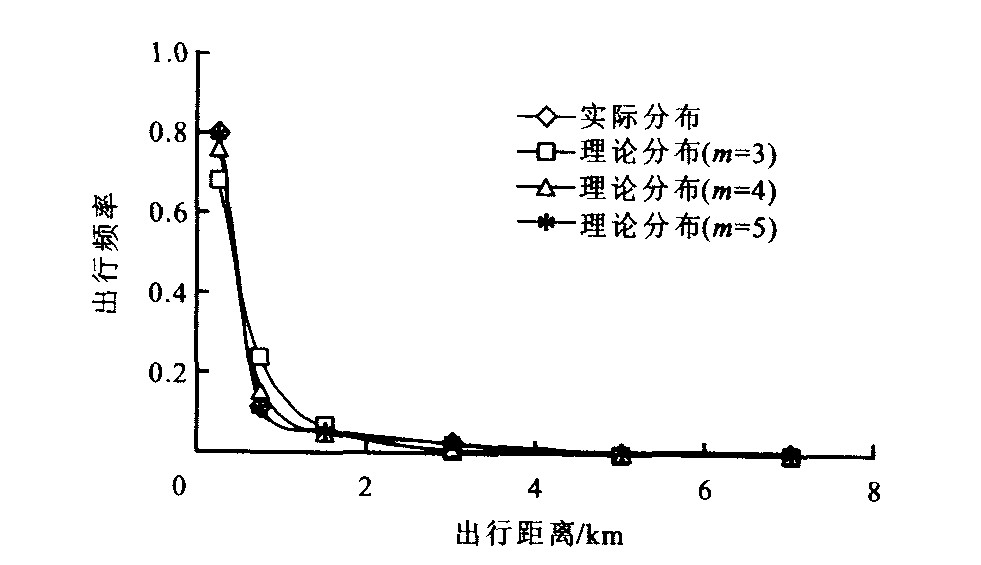Entropy models of inhabitant trip distributions and parameters calibration
-
摘要: 为寻求一种描述各种出行分布情况的普适性模型, 运用最大信息熵原理, 结合数理统计方法, 建立了以原点矩均值为约束条件的新模型体系。为确定模型参数, 提出了熵模型的参数标定方法, 利用长春市居民出行调查数据对参数标定方法进行了验证。数据验证结果显示, 对于步行、自行车、公交车和小汽车四种出行方式, 最高阶原点矩的阶数分别取3、4、5时, 所有模型均通过置信度为95%的χ2检验。通过χ2值和分布曲线的比较发现, 不同出行方式取得最好效果的最高阶原点矩的阶数并不一致, 这种差异取决于出行方式的内在特性。居民出行分布的信息熵模型可以定量描述任意出行方式的分布规律, 所提出的参数标定方法简单有效。Abstract: In order to find some general models to describe all kinds of inhabitant trip distributions, according to the maximum information entropy theory and statistics, new models under the constraints of the means of origin moments were built, a parameters calibration method was put forward to ascertain the parameters of the models. They were validated by the inhabitant trip survey data in Changchun city. The trip modes of walk, bike, bus and car pass χ2 tests with 95% confidence when their orders of the highest origin moments are 3, 4 and 5 respectively. The comparison of χ2 values and inhabitant trip distributions curves shows that the orders are different when the best effects of all trip modes are gotten. The differences result from the inner characteristics of trip modes. Analyzing result indicates that the information entropy models can quantificationally describe the distribution principle of any trip mode, the parameters validation method is simple and effective.
-
Key words:
- traffic planning /
- trip distribution /
- maximum information entropy theory /
- entropy model
-
表 1 居民出行分布的熵模型
Table 1. Entropy models of inhabitant trip distributions
m取值 模型 3 pi=exp(-λ-λ1di-λ2di2-λ3di3) 4 pi=exp(-λ-λ1di-λ2di2-λ3di3-λ4di4) 5 pi=exp(-λ-λ1di-λ2di2-λ3di3-λ4di4-λ5di5) 表 2 步行出行分布
Table 2. Trip distribution by walk
出行距离/km 实际分布 理论分布(m=3) 理论分布(m=4) 理论分布(m=5) < 0.5 0.799 3 0.685 8 0.763 6 0.796 3 0.5~1.0 0.112 9 0.237 7 0.157 6 0.112 5 1.0~2.0 0.059 2 0.061 3 0.049 4 0.059 0 2.0~4.0 0.022 5 0.008 9 0.023 9 0.022 8 4.0~6.0 0.004 0 0.002 8 0.003 5 0.004 7 > 6.0 0.002 0 0.003 4 0.002 0 0.004 8 合计 1.0 1.0 1.0 1.0 χ2值 — 316.078 2 49.040 3 5.125 6 χ2临界值 3 126.2 检验结果 — 通过 通过 通过 表 3 自行车出行分布
Table 3. Trip distribution by bike
出行距离/km 实际分布 理论分布(m=3) 理论分布(m=4) 理论分布(m=5) < 0.5 0.041 4 0.052 9 0.043 7 0.041 9 0.5~1.0 0.190 8 0.146 9 0.148 0 0.193 0 1.0~2.0 0.321 5 0.356 0 0.375 3 0.325 2 2.0~4.0 0.357 1 0.362 0 0.336 4 0.358 9 4.0~6.0 0.071 2 0.061 6 0.077 7 0.067 5 > 6.0 0.018 1 0.020 7 0.018 9 0.013 5 合计 1.0 1.0 1.0 1.0 χ2值 — 39.222 3 41.514 2 3.453 2 χ2临界值 2 002.2 检验结果 — 通过 通过 通过 表 4 公交车出行分布
Table 4. Trip distribution by bus
出行距离/km 实际分布 理论分布(m=3) 理论分布(m=4) 理论分布(m=5) < 0.5 0.010 3 0.019 6 0.010 0 0.008 5 0.5~1.0 0.040 2 0.043 8 0.042 8 0.033 1 1.0~2.0 0.153 8 0.112 9 0.144 3 0.126 6 2.0~4.0 0.280 6 0.327 2 0.284 3 0.233 5 4.0~6.0 0.377 1 0.353 3 0.375 1 0.357 6 > 6.0 0.138 1 0.143 2 0.143 6 0.240 8 合计 1.0 1.0 1.0 1.0 χ2值 — 57.104 4 2.152 6 126.812 χ2临界值 2 167.3 检验结果 — 通过 通过 通过 表 5 小汽车出行分布
Table 5. Trip distribution by car
出行距离/km 实际分布 理论分布(m=3) 理论分布(m=4) 理论分布(m=5) < 0.5 0.029 6 0.025 7 0.026 3 0.023 1 0.5~1.0 0.022 2 0.039 7 0.038 8 0.017 3 1.0~2.0 0.096 3 0.070 2 0.069 6 0.075 1 2.0~4.0 0.148 1 0.168 4 0.182 5 0.116 1 4.0~6.0 0.333 3 0.324 3 0.329 0 0.283 9 > 6.0 0.370 4 0.371 7 0.353 8 0.484 5 合计 1.0 1.0 1.0 1.0 χ2值 — 2.789 4 3.391 7 7.222 8 χ2临界值 167.206 1 检验结果 — 通过 通过 通过 表 6 结果比较
Table 6. Results comparison
出行方式 理论分布(m=3) 理论分布(m=4) 理论分布(m=5) 步行 不好 次好 最好 自行车 次好 不好 最好 公交车 次好 最好 不好 小汽车 最好 次好 不好 -
[1] 沃尔特. 赫利, 胡运权. 城市系统模型[M]. 哈尔滨: 哈尔滨工业大学出版社, 1987. [2] 杨兆升. 交通运输系统规划[M]. 北京: 人民交通出版社, 1998. [3] 杨兆升. 运输系统规划与模型[M]. 北京: 人民交通出版社, 1996. [4] 王炜, 徐吉谦, 杨涛, 等. 城市交通规划[M]. 南京: 东南大学出版社, 1999. [5] 王殿海, 杨兆升, 雷雨龙. 模拟电子云居民分布模型研究[J]. 系统工程理论与实践, 1996, 16(7): 71—74. https://www.cnki.com.cn/Article/CJFDTOTAL-XTLL607.012.htmWang Dian-hai, Yang Zhao-sheng, Lei Yu-long. Research on the inhabitants distribution model by simulation electron cloud[J]. Systems Engineering———Theory and Practice, 1996, 16(7): 71—74. (in Chinese) https://www.cnki.com.cn/Article/CJFDTOTAL-XTLL607.012.htm [6] 周雪梅, 曲大义, 贾洪飞. 信息化条件下的城市交通需求预测[J]. 长安大学学报(自然科学版), 2003, 23(3): 88—90. https://www.cnki.com.cn/Article/CJFDTOTAL-XAGL200303025.htmZhou Xue-mei, Qu Da-yi, Jia Hong-fei. Urban transportation demands prediction in information society[J]. Journal of Chang an University(Natural Science Edition), 2003, 23(3): 88—90. (in Chinese) https://www.cnki.com.cn/Article/CJFDTOTAL-XAGL200303025.htm [7] 李景, 彭国雄. 由路段交通量推算OD出行量方法研究[J]. 交通运输工程学报, 2001, 1(2): 78—82. http://transport.chd.edu.cn/article/id/200102019Li Jing, Peng Guo-xiong. A study on estimating OD trips from observedlink flows[J]. Journal of Traffic and Transportation Engineering, 2001, 1(2): 78—82. (in Chinese) http://transport.chd.edu.cn/article/id/200102019 [8] 裴玉龙, 刘洋, 罗丽君. 公路网路段交通量预测模型研究[J]. 中国公路学报, 1999, 12(4): 101—106. https://www.cnki.com.cn/Article/CJFDTOTAL-ZGGL199904017.htmPei Yu-long, Liu Yang, Luo Li-jun. Model study of highway traffic section volume prediction[J]. China Journal of Highway and Transport, 1999, 12(4): 101—106. (in Chinese) https://www.cnki.com.cn/Article/CJFDTOTAL-ZGGL199904017.htm [9] 哈肯. 信息与自组织[M]. 成都: 四川教育出版社, 1988. [10] 哈肯. 协同学[M]. 北京: 原子能出版社, 1984. [11] 俞礼军, 严海, 严宝杰. 最大熵原理在交通流统计分布模型中的应用[J]. 交通运输工程学报, 2001, 1(3): 91—94. http://transport.chd.edu.cn/article/id/200103023Yu Li-jun, Yan Hai, Yan Bao-jie. Maximum entropy method and it's application in probability density function of traffic flow[J]. Journal of Traffic and Transportation Engineering, 2001, 1(3): 91—94. (in Chinese) http://transport.chd.edu.cn/article/id/200103023 [12] 刘伟平. 交通OD表的实用计算模型[J]. 中国公路学报, 1995, 8(3): 18—24. https://www.cnki.com.cn/Article/CJFDTOTAL-ZGGL503.004.htmLiu Wei-ping. Apractical computation model of traffic OD table[J]. China Journal of Highway and Transport, 1995, 8(3): 18—24. (in Chinese) https://www.cnki.com.cn/Article/CJFDTOTAL-ZGGL503.004.htm -





 下载:
下载:





